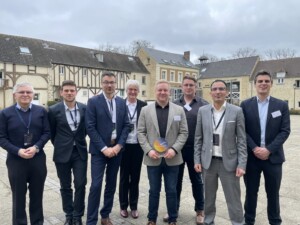LKAB and Predge start-up introduce a new unique solution for conveyor belt maintenance
Conveyor belt systems are composed of numerous components where the failure of a component leads to production stops of varying severity. While idlers may fail more often, they are usually more swiftly replaced than drums and pulleys, which render longer production stops for their repair. Bearings in all these components are very often the failing part of these components.
In the project CoCoP (conveyor belt condition monitoring and health prediction), LKAB and Predge AB have jointly developed a new solution using a digital model, combining component information with the dynamic behaviour of the degradation processes, called a digital twin. The digital twin will operate in parallel with the real-life conveyor belt and continuously monitor and assess each component based on operational and maintenance data. In addition, visual information is used by CoCoP to determine extraordinary hazards to the operation of the conveyor belt using an AI approach.
The results of the CoCoP project create new knowledge to the EIT RawMaterials Community on the practical implementation of predictive maintenance solutions where domain knowledge is used in combination with advanced data analytics, machine learning and principles of AI.
Per Storm, EIT RawMaterials Innovation Hub North Director
The condition monitoring of the components of conveyor belt system models with predictive capabilities is derived using a combination of first principle models and data-driven models (methods from both machine learning and system identification are used here). Idlers, rollers, and pulleys are then monitored, and the condition is predicted to establish estimates for the remaining useful life of individual components. Maintenance can then be appropriately planned and optimised by assessing the future condition of the population of components. Decision support will enable the different roles like operators, maintenance engineers, and management to act on the provided insights. The decision support also includes a scenario-based assessment tool that uses the digital twin to perform what-if analysis.
Flexible SaaS solution for condition monitoring and health prediction of a conveyor belt system
Predge and LKAB are validating a breakthrough innovative and flexible SaaS solution for condition monitoring and health prediction of conveyor belt systems. Customers will be able to cut maintenance costs with better planning opportunities and more reliable production.
Contrary to available solutions on the market, a system-level approach is taken to understand the war and tear of critical components and predict when the systems will fail. The CoCop monitoring and health prediction system will reduce costs for customers due to a reduced amount of unexpected maintenance stops. Additionally, it prolongs the use of different parts of the conveyor system, e.g. bearings, since the system offers access to predictions of the remaining useful life of vital parts. This could potentially push the replacement of a part to a planned maintenance stop later and having a positive impact on both cost, work safety, environment and overall equipment efficiency.
The Predge digital platform providing predictive decision support is a market solution at TRL-9 and was brought to that level by an EIT RawMaterials Booster funding during 2016-2017, originally starting from TRL-5.
We are proud to be recognised as one of the top most promising tech start-ups in Sweden with global potential. With the support of EIT RawMaterials, we have been introduced to the world’s largest innovation community in the raw materials sector.
Bengt Jonsson, CEO at Predge AB
Using the conveyor belt system condition monitoring and health prediction (CBCM-HP) system will help LKAB running a safe and sustainable production of raw materials. Looking ahead, when this project is concluded, the new solution will be available to the partners of the EIT RawMaterials Community, as well as European stakeholders in the mining and mineral process industry.




